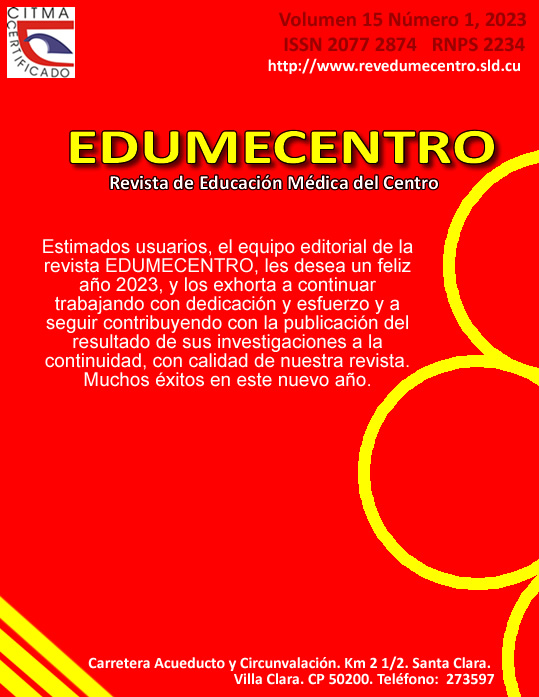School involvement in virtual environments of students with preferences for health careers
Keywords:
education, distance, learning, studentsAbstract
Background: the academic profile of the students of the health careers can be determined according to their characteristics in the school stage, being the school involvement one of the most important.
Objective: to analyze the school involvement in virtual environments of high school students from an educational institution in Metropolitan Lima who are interested in pursuing a health career at the end of their school years.
Methods: cross-sectional, descriptive, observational design study, which included a population of 760 students from 11 to 15 years of age from an educational institution in Metropolitan Lima, out of them 308 students with an interest in a health career were selected as a sample, to whom was applied an adaptation of the School Involvement Scale (EIE-A) considering the virtual learning environment.
Results: a high level of school involvement was found, with an average score of 5.92 ± 0.92 points for a maximum of 7 points. The lowest average was found in the emotional dimension with 5.65±1.34 points, while the behavioral dimension presented the highest average with 6.08±0.98 points. No significant difference was found according to the gender of the students (p<0.05), but it was found in the case of the grade (p<0.05), since the first grade students presented the highest average scores and those of the first grade fourth grade the lowest.
Conclusions: school involvement in virtual environments is high among adolescents who have a preference for health careers, especially among first-year high school students.
Downloads
References
1. Bautista I, Carrera G, Leon E, Laverde D. Evaluation of student satisfaction with virtual classes. Minerva [Internet]. 2020 [citado 03/03/2022];1(2):[aprox. 8 p.]. Disponible en: https://doi.org/10.47460/minerva.v1i2.6
2. Picón GA, González GK, Paredes JN. Desempeño y formación docente en competencias digitales en clases no presenciales durante la pandemia COVID-19. ARANDU UTIC [Internet]. 2021 [citado 02/03/2022];8(1):[aprox. 15 p.]. Disponible en: https://dialnet.unirioja.es/servlet/articulo?codigo=8070339
3. Fernández J, Domínguez JG, Martínez PL. De la educación presencial a la educación a distancia en época de pandemia por Covid 19. Experiencias de los docentes. Rev Electron sobre Cuerpos Académicos y Grupos de Investigación [Internet]. 2020 [citado 03/03/2022];7(14):[aprox. 23 p.]. Disponible en: http://www.cagi.org.mx/index.php/CAGI/article/view/212
4. Rigo D. Los entornos educativos: impacto sobre el compromiso de niños y jóvenes. Rev Educación y Ciencia [Internet]. 2019 [citado 01/03/2022];8(51):[aprox. 8 p.]. Disponible en: http://www.educacionyciencia.org/index.php/educacionyciencia/article/view/493
5. Drane CF, Vernon L, O’Shea S. Vulnerable learners in the age of COVID-19: A scoping review. The Australian Educational Researcher [Internet]. 2020 [citado 03/03/2022];48:[aprox. 19 p.]. Disponible en: https://doi.org/10.1007/s13384-020-00409-5
6. Lucas M, Nelson J, Sims D. Schools’ responses to Covid-19: Pupil engagement in remote learning. [Internet]. Slough: NFER; 2020. Disponible en: https://files.eric.ed.gov/fulltext/ED608590.pdf
7. Jiménez MM, Mantilla E, Huayanay CA, Gil K, García H, Miranda JJ. Mercado de formación y disponibilidad de profesionales de ciencias de la salud en el Perú. Rev Peruana de Medicina Experimental y Salud Pública [Internet]. 2015 [citado 01/03/2022];32:[aprox. 9 p.]. Disponible en: https://www.scielosp.org/article/ssm/content/raw/?resource_ssm_path=/media/assets/rpmesp/v32n1/a07v32n1.pdf
8. Sánchez ME, Andrade P. Análisis factorial confirmatorio de la Escala de Involucramiento Escolar para Adolescentes (EIE-A). Actualidades Investigativas en Educación [Internet]. 2020 [citado 01/03/2022];20(1):[aprox. 20 p.]. Disponible en: https://dx.doi.org/10.15517/aie.v20i1.40020
9. Namicela MY, Flores RP. Visión profesional de estudiantes de nivel secundario, articulada al estudio de demanda académica. INNOVA Research J [Internet]. 2018 [citado 03/03/2022];3(1):[aprox. 10 p.]. Disponible en: https://doi.org/10.33890/innova.v3.n1.2018.418
10. Lara L, Saracostti M, Navarro JJ, de-Toro X, Miranda E, Trigger JM, Fuster J. Compromiso escolar: Desarrollo y validación de un instrumento. Rev Mexicana de Psicología [Internet]. 2018 [citado 03/03/2022];35(1):[aprox. 10 p.]. Disponible en: https://www.researchgate.net/publication/322975518_Compromiso_escolar_Desarrollo_y_validacion_de_un_instrumento
11. Bang H, Won D, Park S. School engagement, self-esteem, and depression of adolescents: The role of sport participation and volunteering activity and gender differences. Children and Youth Services Review [Internet]. 2020 [citado 01/03/2022];(113):[aprox. 12 p.]. Disponible en: https://doi.org/10.1016/j.childyouth.2020.105012
12. Pérez M, Molero M, Simón M, Barragán AB, Martos Á, Ruiz NF, Gázquez JJ. Engagement académico e inteligencia emocional en estudiantes de Ciencias de la Salud. Rev de Psicología y Educación [Internet]. 2020 [citado 02/03/2022];15(1):[aprox. 10 p.]. Disponible en: https://doi.org/10.23923/rpye2020.01.187
13. Martínez M, Suárez JM, Valiente C. Implicación estudiantil y parental en los deberes escolares: diferencias según el curso, género y rendimiento académico. Rev de Psicología y Educación [Internet]. 2020 [citado 28/02/2022]; 15(2):[aprox. 14 p.]. Disponible en: https://doi.org/10.23923/rpye2020.02.193
14. Veliz FB, Díaz MY, Rivera EG, Vega EO. Compromiso hacia las tareas escolares en estudiantes de primaria de dos instituciones educativas de Lima Metropolitana, Perú. Rev Andina de Educación [Internet]. 2021 [citado 25/02/2022];4(1):[aprox. 7 p.]. Disponible en: https://doi.org/10.32719/26312816.2020.4.1.11
15. Salmela K, Upadyaya K, Vinni J, Hietajärvi L. Adolescents' Longitudinal School Engagement and Burnout Before and During COVID‐19—The Role of Socio‐Emotional Skills. J of Research on Adolescence [Internet]. 2021 [citado 01/03/2022];31(3):[aprox. 11 p.]. Disponible en: https://doi.org/10.1111/jora.12654
Published
How to Cite
Issue
Section
License
Los autores que publican en esta revista están de acuerdo con los siguientes términos:- Los autores/as conservarán sus derechos de autor y ceden a la revista el derecho de primera publicación de su obra, el cuál estará simultáneamente sujeto a una Licencia Creative Commons Reconocimiento-NoComercial-CompartirIgual 4.0 Internacional (CC BY-NC-SA 4.0) que permite a terceros compartir la obra siempre que se indique su autor y su primera publicación esta revista.
- Los autores pueden establecer por separado acuerdos adicionales para la distribución no exclusiva de la versión de la obra publicada en la revista (por ejemplo, situarlo en un repositorio institucional o publicarlo en un libro), con un reconocimiento de su publicación inicial en esta revista.
- Se permite y se anima a los autores a difundir sus trabajos electrónicamente (por ejemplo, en repositorios institucionales o en su propio sitio web) antes y durante el proceso de envío, ya que puede dar lugar a intercambios productivos, así como a una citación más temprana y mayor de los trabajos publicados (Véase The Effect of Open Access) (en inglés).










